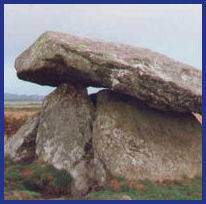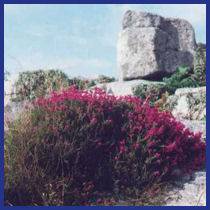Chun Quoit and Chun Castle
Chun Quoit
OS Grid ref:- SW402340
 Chun Quoit burial chamber (dolmen) is arguably one of the best preserved quoits in the West
Penwith region and dates from Neolithic times. The quoit stands on bleak atmospheric moorland slopes about a mile from the sea near Great Bosullow.
Chun Quoit burial chamber (dolmen) is arguably one of the best preserved quoits in the West
Penwith region and dates from Neolithic times. The quoit stands on bleak atmospheric moorland slopes about a mile from the sea near Great Bosullow.
A huge capstone with a cupmark, stands at a height of about two metres and is supported by four standing stones lies on top of the closed chamber, The capstone measures 3.3metres (11ft) by 3metres(10ft). Access is gained to the interior of the monument through a hole in the lower right side of the SSE base slab. The Quoit was probably covered by an earth mound, evidence of which survives. Excavations were carried out in 1871 but no significant finds resulted.
The Quoit derives its name from the Cornish "Chy-an-Woone" which translates as "the house on the downs"
Chun Quoit can be accessed via a track leading from a nearby farm.
Chun Castle
OS Grid ref:- SW 402339
 The Iron Age Hill Fort of Chun Castle lies just to the east of Chun Quoit and is visible from the Quoit. It was constructed in the third and second centuries B.C.
and was probably occupied both before and after the Roman occupation of Britain
The Iron Age Hill Fort of Chun Castle lies just to the east of Chun Quoit and is visible from the Quoit. It was constructed in the third and second centuries B.C.
and was probably occupied both before and after the Roman occupation of Britain
The castle measures 84 metres (280ft) in diameter and consisted of two concentric granite walls with rock cut ditches. Its ancient stone walls stand up to 2.7metres (9 ft) high, they may once have stood at 6 metres (20ft) high. There is an entrance on the south-west which is flanked by large stone gate-posts. Within its walls there are traces of hut foundations and a blocked-up well near the north-west rampart, and several smelting-pits have been discovered on the site
Chun Castle was probably constructed to protect the tin which was then being mined locally and stands astride the route of the prehistoric trackway known as the Old St. Ives Road. Much of the stone was taken to pave the streets of nearby Penzance, the castle remains, nevertheless, highly impressive.